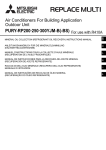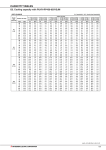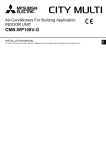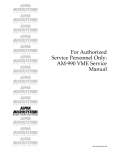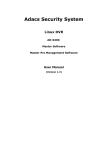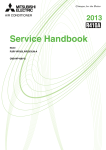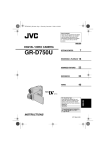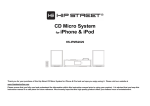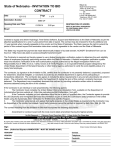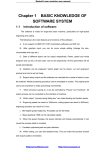Download Mitsubishi Electric PUHY-RP300 Installation manual
Transcript
MANUEL D’INSTRUCTIONS POUR LA COLLECTE D’HUILE MINÉRALE (RÉCUPÉRATION DE L’HUILE FRIGORIFIQUE) D RACCOLTA DELL’OLIO MINERALE (RECUPERO DELL’OLIO REFRIGERANTE) MANUALE DI ISTRUZIONI I MANUAL DE INSTRUÇÕES DE RECOLHA DE ÓLEO MINERAL (RECUPERAÇÃO DO ÓLEO REFRIGERANTE) P MANUAL DE INSTRUCCIONES PARA LA RECOGIDA DE ACEITE MINERAL (RECUPERACIÓN DE ACEITE REFRIGERANTE) F ANLEITUNGSHANDBUCH FÜR DIE MINERALÖLSAMMLUNG (KÄLTEMITTELÖLENTNAHME) E MINERAL OIL COLLECTION (REFRIGERANT OIL RECOVERY) INSTRUCTIONS MANUAL GB Air Conditioners For Building Application Outdoor Unit PUHY-RP200·250YJM-B(-BS) For use with R410A PUHY-RP300·350YJM-B(-BS) 1. Unit Components Figure 1 Top view of the refrigerant pipes inside an outdoor unit H GB I CJ5 J CJ2 CJ1 CJ4 B C D A G F CJ4 CJ3 E Figure 2 Valve types allocations 2 A: Refrigerant charge port (for automatic charging only) B: Check joint on the low-pressure side A port through which additional refrigerant CJ5 is charged after the completion of refrigerant oil recovery operation C: Service port on the liquid valve Connecting port to the refrigerant circuit • Evacuation port (liquid side) • A port through which refrigerant for the indoor units is charged D: Service port on the gas valve Connecting port to the refrigerant circuit • Evacuation port (gas side) • A port through which refrigerant for the indoor units is charged E: A valve to be closed after the completion of refrigerant oil recovery operation (BV3) (Be sure to close this valve after the completion of refrigerant oil recovery operation.) F: Liquid valve G: Gas valve H: O/T I: ACC J: COMP CJ3: Refrigerant charge port CJ4: Oil sampling port CJ5: Refrigerant oil discharge port 2. Refrigerant Oil Recovery Operation Flow 2.1 Refrigerant oil recovery operation monitor display 1. How to read the LED on the service monitor Units' operation status can be monitored on the LED display by setting the dipswitches SW1-1 through 1-10 on the MAIN board of the outdoor units. Four 7-segment LEDs are used to display numerical values, flags, and alphabets to display various information. GB 7SEG LED The LEDs display such information as pressure and temperature in numerical values and operating conditions and the ON/OFF status of solenoid valve as flags. ● Display of numerical values Example:When the pressure sensor reads 18.8 kg/cm2G (Item No. 58) * The unit of pressure is in kg/cm2G. * Use the following conversion formula to convert the displayed value into a value in SI unit (MPa). SI unit (MPa) = Displayed value (kg/cm2G) 0.098 ● Flag display (Each set of two lines in vertical alignment indicates a flag.) Example:Outdoor unit in the 3-minute restart delay mode. (Item No. 14) LD1 LD2 LD3 LD4 LD5 LD6 LD7 LD8 2. Table of items that can be monitored on the LED on the outdoor unit circuit board No SW1 Display content LED display 1 2 3 4 5 6 7 8 9 10 58 0 1 0 1 1 1 0 0 0 0 High pressure (kgf/cm2G) -99.9 to 999.9 59 1 1 0 1 1 1 0 0 0 0 Low pressure (kgf/cm2G) -99.9 to 999.9 -99.9 to 999.9 LD1 LD2 LD3 LD4 LD5 LD6 LD7 60 0 0 1 1 1 1 0 0 0 0 Intermediate pressure (kgf/cm2G) 45 1 0 1 1 0 1 0 0 0 0 Discharge temperature (°C) -99.9 to 999.9 rEP steps 131 1 1 0 0 0 0 0 1 0 0 Refrigerant oil recovery operation steps 122 0 1 0 1 1 1 1 0 0 0 Refrigerant oil recovery remaining time (*1) 120 0 0 0 1 1 1 1 0 0 0 Refrigerant oil recovery completion indicator flag Refrigerant charge adjustment completion indicator flag LD8 LD9 LD10 Notes Reversed display 0 to 9999 S-1 (0) r-1 (0) (*2) Reversed display (*1) The initial remaining time that indicates the refrigerant oil recovery is 80. A countdown will start on step 3 in the cooling mode and step 4 in the heating mode. The countdown does not include the time for checking the refrigerant charge amount, which takes place after the completion of refrigerant oil recovery operation. (*2) S-1: Refrigerant oil recovery complete, S-0: Refrigerant oil recovery incomplete, r-1: Refrigerant charge adjustment complete, r-0: Refrigerant charge adjustment incomplete. 3 2.2 Procedures for refrigerant oil recovery 1Evacuating the existing pipes, and ensuring air tightness GB Procedure 1 Charge airtight gas through the service port on both the liquid and gas valves. The air tightness should be 4.15 MPa. After checking the air tightness, evacuate the air through the service port on both the liquid and gas valves. Gas valve Liquid valve 2Refrigerant charging Procedure 2 Charge the required amount of refrigerant (indoor units + pipes) through both the liquid and gas service port valves. See the table below for the required amount of refrigerant for the indoor units. To calculate the required amount of refrigerant charged for the pipes, refer to 10.1. “Calculation of additional refrigerant charge” in the installation manual on the CD-ROM. If there is excess refrigerant that cannot be charged, use it during oil recovery operation at step 4 (cooling operation) or step 5 (heating operation). * Refer to “6 Refrigerant oil recovery operation” for details. Total indoor unit capacity and required refrigerant charge Total indoor unit capacity Liquid valve Gas valve Refrigerant charge for the indoor units (kg) - 80 2.0 81 - 160 2.5 161 - 330 3.0 331 - 390 3.5 391 - 480 4.5 481 - 630 5.0 631 - 710 6.0 711 - 800 8.0 801 - 890 9.0 891 - 1070 10.0 1071 - 12.0 * After charging the required amount of refrigerant to the existing pipes, open the valve so that the pressure in the existing pipes and outdoor unit are equal. (Refer to Procedure 3.) Do not open the valve on the outdoor unit when the existing pipes are under vacuum. Doing so may cause the refrigerant that is dissolved in the refrigerant oil in the compressor to form and cause some oil to migrate to the existing pipes, resulting in insufficient lubrication. 4 3Opening the valves Procedure 3 Open both the liquid and gas valves. (In a system with multiple outdoor units, open the liquid and gas valves on ALL outdoor units. All the outdoor units will operate during refrigerant oil recovery operation.) * Use a hexagonal wrench to open the valves. Refer to the table below for the proper wrench size. Hexagonal wrench size Gas 5, 6, 8 HP 4 mm 6 mm 10, 12, 14 HP 4 mm 10 mm A Liquid valve Gas valve 4Connecting the refrigerant cylinder(s) Procedure 4 If the required amount of refrigerant is not charged, disconnect the charging hose connected to the refrigerant cylinder from the service port on liquid or gas side, and connect the charging hose to the refrigerant charge port CJ3 (only for automatic charging). * In a system with multiple outdoor units, connect a cylinder to each outdoor unit. Check that each cylinder has the correct amount of refrigerant. * If the amount of refrigerant is insufficient, the units may stop during refrigerant oil recovery or it may take longer than usual to complete a test run. Refrigerant charge port (CJ3) 5Setting the unit address and checking for proper system operation Procedure 5 Set the unit address, turn on the power, and check for proper operation of the system. * If an attempt is made to operate the outdoor unit before the refrigerant oil recovery operation is complete, an error code 7116 will appear on the remote controller. This does not indicate a malfunction. Wait for the oil recovery operation to be completed. The error code 7116 will go off upon completion of oil recovery operation. 5 GB A Liquid 6Refrigerant oil recovery operation GB Procedure 6 Set the dipswitches 3-1 and 4-8 to ON in that order. The compressor turns on, and oil recovery operation starts. * When multiple outdoor units are connected in a system, refer to the followings for which dipswitch should be operated. • When different capacity outdoor units are combined, operate the dipswitch on the larger capacity unit. • When the same capacity outdoor units are combined, operate the dipswitch on the unit whose address is smaller. Check the operation mode (cooling or heating) during the refrigerant oil recovery operation. * Before the refrigerant oil recovery operation is started, the operation mode (cooling or heating) is automatically selected. When outside temperature is 20°C or above, cooling mode is selected. When outside temperature is lower than 15°C, heating mode is selected. When outside temperature is between 15°C and 20°C, operation mode varies depending on the indoor temperature. When indoor temperature is 23°C or below, heating mode is selected. When indoor temperature is 23°C or above, cooling mode is selected. * Turn the dipswitches 1-1, 1-2, 1-3, and 1-6 to ON to check the operation mode on the outdoor unit LED as follows. (The operation mode can also be checked on the display of local remote controller or maintenance tool.) When cooling mode is selected When heating mode is selected Procedure 7 The refrigerant oil recovery operation is explained in the next page. Wait for the operation to be automatically completed. * If there was excess refrigerant that had not been charged at “2Refrigerant charging”, charge it during oil recovery operation at step 4 (cooling operation) or step 5 (heating operation). After charging the refrigerant, close the valve on the refrigerant cylinder. (Even when the required amount of refrigerant is already charged, refrigerant charge is automatically adjusted.) * If the cylinder runs out of refrigerant during the refrigerant oil recovery operation, continue the operation and replace the cylinder. * If the cumulative oil recovery operation hour is more than three and a half hours, turn the dipswitches 4-8 and 3-1 to OFF to stop the operation and turn the dipswitches 4-7 on all the units (OC, OS1, and OS2) to OFF. LED monitor Address switches Close the panel at bottom front of the unit. SW5 SW3 SW4 OFF ON SW3-1 1 2 3 4 5 6 7 8 9 10 SW1 Dipswitches SW2 Each dipswitch has 1 to 10 switches from the top. (OFF-left, ON-right) (e.g., SW3-1 is the top switch of SW3. The figure at left indicates that only SW3-1 is set to ON.) SW3 The refrigerant oil recovery operation is explained in the following flow charts. Wait for the operation to be automatically completed. * Refer to the table at right for the maximum amount of refrigerant charge. Do not exceed the maximum amount. If the refrigerant oil recovery operation does not finish after the maximum amount of refrigerant is charged, close the valve on refrigerant cylinder, and wait for the operation to be completed automatically. * If the cylinder runs out of refrigerant during the refrigerant oil recovery operation, continue the operation and replace the cylinder. Outdoor unit capacity and the maximum amount of refrigerant charge Outdoor unit capacity RP200 RP250 RP300 - RP900 Maximum amount of refrigerant charge (except for the indoor units) (kg) 18.0 18.0 25.0 If the length or diameter of the refrigerant pipe is known, take the following procedure. If more than the amount of refrigerant that you calculated is charged into the system in auto-charge mode, then there is no problem if you wish to close the cylinder valve while the unit is operating. The unit will stop operating of its own accord. 6 Disconnect the charging hose, which is connected to the refrigerant cylinder, from the refrigerant charge port (only for automatic charging), and connect the charging hose to the check joint on the low-pressure side. If the length or diameter of the refrigerant pipe is unknown, add 1.5 kg of refrigerant for each outdoor unit. * There is no need to adjust the refrigerant charge after the completion of the refrigerant oil recovery operation if the units are operated in the cooling mode. * If the total amount of refrigerant to be charged during refrigerant oil recovery operation exceeds the maximum amount in the table below, refrigerant does not need to be added. Outdoor unit capacity and the maximum amount of refrigerant charge Outdoor unit capacity RP200 RP250 RP300 - RP900 Maximum amount of refrigerant charge (except for the indoor units) (kg) 18.0 18.0 25.0 * If a built-in pressure gauge is connected to the check joint on the low-pressure side, use the check joint on the liquid valve in the heating mode, and the check joint on the gas valve in the cooling mode. 7Check for successful completion of the refrigerant oil recovery operation. Procedure 8 Turn the dipswitches 1-4, 1-5, 1-6, and 1-7 to ON to verify that the refrigerant oil recovery operation is completed. “S-1” or “r-1” on the outdoor unit’s LED indicates a successful completion. * When multiple outdoor units are connected in a system, refer to the followings for which dipswitch should be operated. • When different capacity outdoor units are combined, operate the dipswitch on the larger capacity unit. • When the same capacity outdoor units are combined, operate the dipswitch on the unit whose address is smaller. LED “S-1” “r-1”: The refrigerant oil recovery operation is successfully completed. Go to the next procedure. “S-1” “r-0”: The refrigerant charge adjustment is not completed, but regular air conditioning operation can be started. If there was excess refrigerant that had not been charged, charge it through the low-pressure check joint (CJ2) during the air conditioning operation. “S-0” “r-1”: The refrigerant oil recovery operation is not completed. To restart the refrigerant oil recovery operation, set the dipswitches 3-1 and 4-8 to ON in that order. “S-0” “r-0”: The refrigerant oil recovery operation is not completed. To restart the refrigerant oil recovery operation, set the dipswitches 3-1 and 4-8 to ON in that order. 7 GB Check joint on the low-pressure side 8Disconnecting the cylinder Procedure 9 After completing the oil recovery operation, close the valve on the cylinder, and disconnect the cylinder within five minutes. 9Recording the amount of refrigerant that was charged GB Procedure 10 Write on the control box panel the amount of refrigerant charged. 0Closing the valve on the connecting port to the refrigerant circuit Procedure 11 Close BV3 completely. The refrigerant oil recovered from the existing pipes is sealed in an oil recovery vessel. Turn the valve clockwise by 90 degrees. * Use a tool if necessary. 8 This product is designed and intended for use in the residential, commercial and light-industrial environment. The product at hand is based on the following EU regulations: • Low Voltage Directive 2006/95/EC • Electromagnetic Compatibility Directive 2004/108/EC • Pressure Equipment Directive 97/23/EC Please be sure to put the contact address/telephone number on this manual before handing it to the customer. HEAD OFFICE: TOKYO BLDG., 2-7-3, MARUNOUCHI, CHIYODA-KU, TOKYO 100-8310, JAPAN Authorized representative in EU: MITSUBISHI ELECTRIC EUROPE B.V. HARMAN HOUSE, 1 GEORGE STAREET, UXBRIDGE, MIDDLESEX UB8 1QQ, U.K. WT06217X01









